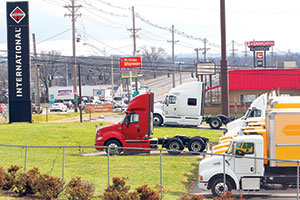Senior Reporter
Prices Lower, Sales Slower for Used Class 8 Trucks

With inventories at the highest level in more than a decade, used Class 8 trucks were priced lower and selling slower in January compared with a year earlier, a pattern likely to continue throughout 2016, analysts said.
The average price for a used Class 8 truck in January was $45,155, down about 6% from a year earlier, according to ACT Research.
Inventories are higher than at any time since the recession of 2000-2001 that spewed used trucks back into the marketplace in “absolute droves,” ACT analyst Steve Tam said.
However, hard numbers for inventory are elusive, he said.
“Nobody in the industry that I am aware of has a good number on what the actual number of trucks in inventory is,” he said, “but, for sure, all of the comment from the dealers we talk with is that their inventory levels are the highest they have seen in quite some time.”
Don Ake, an analyst with the research firm FTR, told Transport Topics that an elevated number of new trucks were sold in 2015 when they reached the fourth-highest total ever, and trades were associated with those trucks.
“So your used truck inventory went up,” he said. “However, now sales have stalled on the new side, so it is reasonable to assume they have stalled on the used side, too, with an inventory that is at a high point.”
Analyst Rhem Wood of BB&T Capital Markets said in an investor note that pricing for used trucks is getting softer.
He said pricing in January fell 15%, which was a steeper decline than the expectations that prices would be down by 5% to 10% for the coming year.
“Looking forward, we expect the new-used spread to continue to widen in 2016 and maybe 2017, which could put additional pressure on the new Class 8 market,” Wood said.
Many fleets have indicated used-truck prices “keep them awake at night,” ACT’s Tam said.
“It’s just that drop-off in values. For many of them, used-truck sales have been a profit center as prices ran up, and now they are seeing pressure on that,” he said.
ACT surveys dealers, wholesalers and auctioneers, as well as a few large fleets, to determine average prices.
The pricing has weakened despite lower mileage, which dropped to 494,255, down 8% from 536,842 a year earlier but up about 2% from December, ACT said.
The industry is having to adapt to the new normal of a larger supply of trucks, and preliminary data for January point to another month of extremely low volume, said Chris Visser, an analyst with the National Automobile Dealers Association.
NADA said 2013 sleepers were selling last month for an estimated $40,000 on the wholesale market, down from about $70,000 a year earlier. Likewise, model year 2012 sleepers were closer to $40,000 in January, after beginning 2015 at almost $60,000. In addition, 2011 sleepers also were selling in the low $40,000 range after bouncing between the mid-$40,000s to above $50,000 over the course of 2015.
Sleepers from 2007-2010 ranged from about $15,000 to about $25,000, depending on age.
At the same time, Visser said, “The fourth quarter of 2015 showed a 30% decline in the number of trucks retailed per rooftop from the previous three quarters.”
BB&T’s Wood added that credit terms are tightening and that the business environment is woeful for small fleets relying on the spot market, many of whom are typical used-truck buyers.
“Spot rates are horrible, down 15% year-over-year, and the small and medium-size carriers are not feeling great. Thus, we expect 2016 rate increases to be slightly up for the big guys, flat at best for small guys.”
Tam said small and medium carriers were the main buyers of used trucks.
John Larkin, an analyst with Stifel, Nicolaus & Co., wrote in a note that Heartland Express CEO Michael Gerdin said during a recent conference that his company had aggressively reduced its average tractor age to 1.25 years at the end of 2015, compared with 2 years a year earlier, to improve fuel mileage and reduce maintenance costs.
That reduction positioned the carrier to slow equipment purchases, “thus avoiding selling as large a volume of equipment as it had the past few years, now that the used-tractor market is significantly weakening,” Larkin said. “We suspect that Heartland saw the weakening in the used-tractor market coming, looking ahead to when the 2011-2012 tractors were expected to be traded in, and successfully got ahead of the issue.”
Heartland Express ranks No. 39 on the Transport Topics Top 100 list of the largest U.S. and Canadian for-hire carriers. It operates about 4,700 Class 8 tractors.




